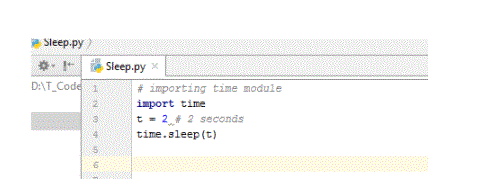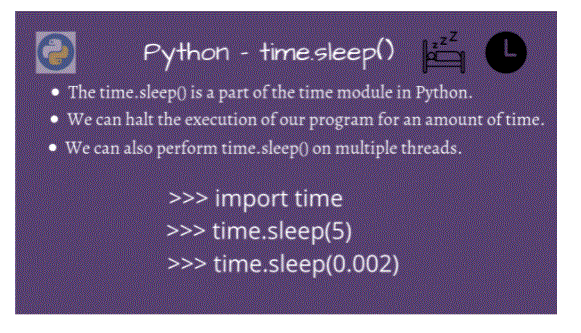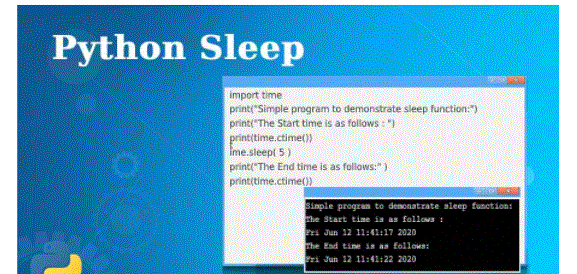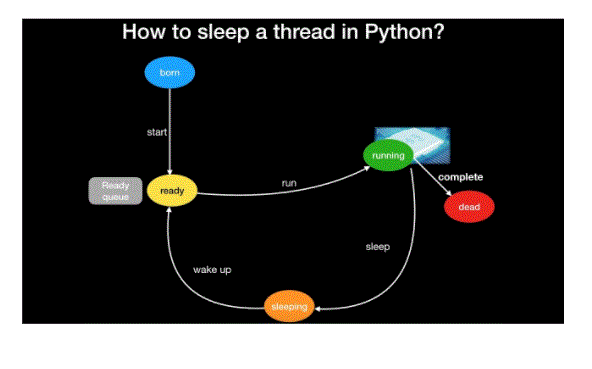
The sleep() function suspends (waits) execution of the current thread for a given number of seconds. Python has a module named time which provides several useful functions to handle time-related tasks. The sleep() function suspends execution of the current thread for a given number of seconds.
- Introduction to Python Sleep Method
- Syntax for Python time sleep
- Characteristics of sleep Function
- Python sleep example
- Different delay time of python sleep()
- Python thread sleep
- Why sleep Function
- Dramatic printing using sleep()
- The Accuracy of time.sleep()
- Conclusion
- Sleep function () pauses (wait) to perform current series for a given number of seconds.
- Python has a timely module that provides a number of useful functions for managing time-related tasks. One of the most popular activities among them is sleep ().
- Sleep function () temporarily suspends the use of the current series for a given number of seconds.
- Sometimes, there is a need to stop the flow of the system in order for a few more actions to occur or simply because of the necessary usage. sleep () can be useful in such a situation that provides an accurate and flexible way to stop the flow of code at any time. This activity discusses the details of this activity.
Introduction to Python Sleep Method:
- # importing time module
- import
- time
- (
- “Before the sleep statement”
- ) time.sleep(
- 5
- )
- (
- “After the sleep statement”
- )
- import
- time
- time
- .sleep
- (0
- .100
- )
Syntax for Python time sleep:
Python time sleep () function syntax
Python sleep () is a python time module. So, first we have to enter the time module and then use this method. How to use the python sleep function) is:
Here the argument for the sleep () method t is seconds. That is, if the statement period.sleep (t) using the following line of code will be used after t-seconds. See the following example:

If you use the code above you will see that the second print comes in after 5 seconds. So you can make a delay in your code as needed.
Arguments can be at a floating price again in order to have a more accurate delay. For example you want a 100 millisecond delay of 0.1 seconds, as follows:
- Sleep function () temporarily suspends the use of the current series for a given number of seconds. In the case of single-stranded programs, sleep () temporarily suspends network performance and process. However, the function stops the series instead of the whole process in multi-threaded systems.
- Python sleep time is three to six times, equivalent to 18 hours.
- If you have a Python program and want to make it wait, you can use a simple task like this: time. sleep (x) when x is the number of seconds you want your system to wait.
- Python sleep () is a function used to delay coding by the number of seconds provided as sleep input (). The sleep order () is part of the time module. You can use the sleep () function to pause your code usage. Example: Using a sleep function () in Python.
Characteristics of sleep Function:

- start import timeTime = time.t time () for i in grade (0,5): print (i)
- # make a delay of 1 second
- time.sleep (1)
- endTime = time.time ()
- elapsedTime = endTime – startTime print (
- “Past tense =% s”
- % time over)
- This will release:
- 0 1 2 3 4 Past = 5.059988975524902
Python sleep example:
Let’s look at the following example of a python sleep function.
The elapsed time is greater than 5 because each time in the loop, usage is suspended for 1 second. Extra time is due to system execution time, operating system configuration, etc.

- import
- time
- for
- i
- in the middle
- [
- .5
- ,
- .1
- ,
- 1
- ,
- 2
- ]:
- (
- Waiting for% s “
- % i, end =
- ”
- )
- (
- “seconds”
- ) time.sleep (i)
- Waiting
- for
- 0.5 seconds Waiting
- for
- 0.1 seconds Waiting
- for
- 1 sec Waiting
- for
- 2 seconds
Different delay time of python sleep():
Sometimes you may need a delay for different seconds of time. You can do the following:
This will release:
In the above program, we can see that we first need to import a time module in order to use the sleep function () as is the function of the time module in Python. We can see the first time it is displayed using the ctime () function of the time module, which shows the current time. Then we saw the end time to indicate the use of the sleep () function to stop the operation and then show the current time when the function is stopped making the string using the sleep () function.
- import
- time
- from
- sewing
- import
- Series
- Class employee (Series):
- def run (self):
- for
- x
- in the middle
- width (
- 0
- ,
- 11
- ): print (x) time.sleep (
- 1
- )
- Class Waiter (Series):
- def run (self):
- for
- x
- in the middle
- width (
- 100
- ,
- 103
- ): print (x) time.sleep (
- 5
- ) print (
- “Series of Excellent Workers”
- ) Worker (). Start () print (
- “Starting the Waiter series”
- ) Server (). Start () print (
- “Done”
- )
Python thread sleep:
The Python time sleep function () is the most important form of multithreading. Below is a simple example showing that the python sleep function stops the performance of the current series only in a multi-stranded system.
The image below shows the output generated by the sleeping pattern of the python string above. It is very clear that only the cables are set to work and not the whole system with python sleep function. That’s all about python sleep function or python sleep function.

Why sleep Function:
Python sleep function is used to add latency to system performance. We can use the python sleep function to stop system performance at a given time in seconds. Note that the python sleep function actually stops the current cord release only, not the entire system.
- # import time module
- import time
- message = “Hello !!! i am attempting to make doubts”
- to Maine in an exceedingly message:
- # to print every letter of the message
- Print (i)
- time.sleep (0.3)
Dramatic printing using sleep():
You may must print a special message, you’ll be able to do the following:
If you employ the code higher than, you’ll see that when printing all the letters of the message it takes time, that appears strange. In the higher than a program, we’ve seen that we’ve a personality unit outlined during this program thus we tend to try and print letter by letter victimizing the sleep perform (). During this case, we’ve a quantity ofwe haveero.3 seconds. This suggests that after zero. In 3 seconds, every letter is written employing a loop, with a place to begin as a zero indicator of the length of the given character unit to the tip of the given unit length and sleep performance. to visualise the visual result, we’ve to try to do higher than the program within the Python native editor.
Now let’s verify a number of the utilisation of sleep perform (), that is vital for several mixtures as sleep perform () is employed to prevent current output, that is barely done throughout the multi-integration method.
The Accuracy of time.sleep():
The time.sleep () function uses the basic sleep () function of the operating system. Finally, there are limitations of this work. For example, for standard Windows installations, the minimum downtime you can hold is 10 – 13 milliseconds. Linux kernels tend to have a higher marking value, with intervals usually closer to 1 milliseconds. Note that on Linux, you can install the RT_PREEMPT patch, which allows you to have a semi-realtime kernel. Using a real-time kernel will improve the accuracy of the time.sleep () function. However, unless you want to get a little sleep, you can ignore this information.
Using Decorators To Add Time.sleep () Command
Decorators are used to create simple syntax for calling high order functions. When can we use decorative items? Suppose we have to check the function again, or the user has to download the file again, or you have to check the interaction status after a certain time. You need a time delay between the first attempt and the second attempt. Therefore, you can use decorators in situations where you need to check repeatedly and you need a time delay.

Conclusion
In this article, we conclude by looking at the syntax and functionality of Python’s sleep () function in examples. In this article, we have seen how this sleep function () can be defined. We have therefore seen that we need to introduce a time module that offers a variety of options, and sleep function () is the most popular form of time module in Python. In this article, we have seen a simple example showing a sleeper () that has a number of seconds called an argument. Lastly, we saw sleep () applications, which are used in amazing printing and many configurations.





